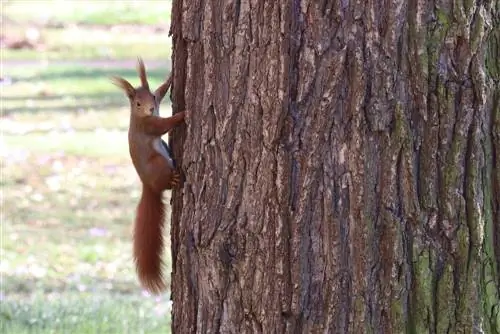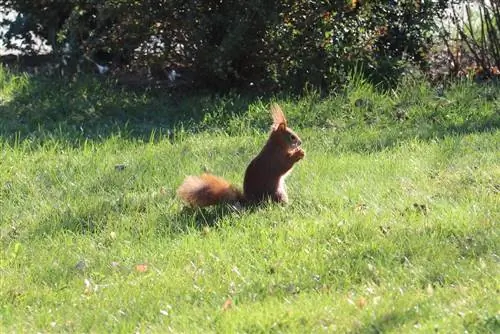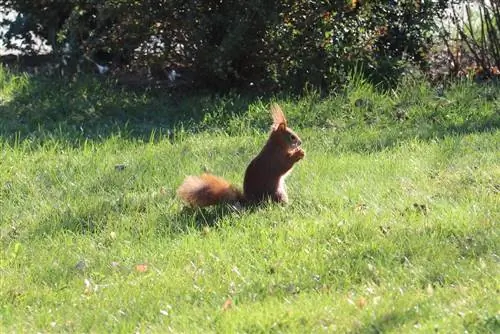- Author admin [email protected].
- Public 2023-12-17 03:39.
- Last modified 2025-01-24 12:45.
Squirrels are among the most popular visitors to the garden, as the furry rodents bring great joy to children and nature lovers. But the animals are becoming increasingly rare as their natural habitats are threatened. With a squirrel coop you can offer the animals a safe retreat that serves as a birthing place and winter resting place. In addition to the correct construction, it is also important to align the housing.
Natural Kobel
Squirrels live in dense coniferous forests and in nature they build nests out of twigs, which they weave into a cave high up in the treetops. They usually build their nests in forks of branches or on branching branches near the trunk. Abandoned nests of hawks or magpies are also accepted as a basic structure and converted. The Kobel serve as a place of retreat and birthplace for the squirrels. During the cold season, the rodents hibernate in the nest. To ensure that the animals are optimally protected, the Kobel is built accordingly:
- Outer diameter: approx. 30 to 50 centimeters
- Inside diameter: approx. 15 to 20 centimeters
- Back exit serves as an escape hole in case of danger
- Front exit is higher than the rear hatch
- Waterproof and windproof features with moss, bark and leaves
Each squirrel nest has two exits. While the front loophole serves as a normal entrance and exit, the animals only use the rear exit in dangerous situations when the front hole is under siege by a predator.
Note:
If you build a squirrel house and only include one escape hole, the animal will build itself an escape hole within a very short time.
Materials and tools
Only use materials that are environmentally friendly and do not harm the he alth of the animals. Softwoods such as beech, pine or maple are ideal. Pine wood is usually cheaper than solid wood panels made from beech or maple. Prices vary depending on the provider. In the hardware store, the costs per square meter are between 18 and 35 euros. Use solid wood panels that are untreated. The wooden panels should be about 1.5 centimeters thick.
- Wooden board for the base area: 26 x 26 centimeters
- four side panels: 26 x 30 centimeters
- Wood panel for the roof: 26 x 30 centimeters
- two hinges
- Wooden slat for fastening: 4 x 30 centimeters
- Screws or nails
- weatherproof cords

The roof panel is slightly longer than the right and left side walls. This means it protrudes slightly so that the front entrance is better protected from rain. The wood is coated with harmless products before construction so that it can withstand the weather for longer. You can use linseed oil, which closes the pores and prevents mold formation due to moisture accumulation. After applying the first coat, let it dry. Repeat the process several times until a solid layer has formed on the wood. Building a Kobel requires a few tools that are available in most households:
- Jigsaw or hand saw and circle cutter
- Compass and ruler
- pencil
- biological glaze: linseed oil
- Sandpaper
Build a nesting box
Draw the dimensions for the six panels on the wood and saw the components to size with a jigsaw or hand saw. Mark a hole on the front wall with the compass. It serves as the main entrance and should be placed in one of the upper corners. On the right side wall, a hole is drawn in one of the bottom corners.
- pregnant animals must fit through the loopholes
- Holes with a diameter of eight centimeters
- cut with jigsaw or circular cutter
- sand sharp edges with sandpaper
Attach the two hinges to the panel that serves as the back panel and to the roof panel. This gives you the opportunity to open the bowl later for checking and cleaning. Put the four side walls together to form a box and fasten them with screws or nails. Place the box on the base plate and screw it to the side walls.
Tip:
Cut the back wall about two centimeters longer than the front wall and cut the side walls at an angle. This means that the roof plate lies at an angle and rainwater can drain off better.
Fastening
So that you can hang the nesting box on a tree, screw the oblong wooden plate to the back wall. Arrange the plate so that it protrudes two centimeters on each side. It should be attached directly under the roof panel so that the box hangs stably later. Place the screws where the side panels sit on the back panel. This will prevent screw tips from protruding into the interior.
Interior

Squirrels like soft padding in the nest so that their offspring are optimally protected from cold and wet conditions. You can hang the house in its raw state so that the animals can take care of the interior design themselves. If you want to make the dwelling inviting, you can line it with natural materials. You can use everything you find in nature:
- Straw and pieces of bark as a substrate
- a layer of leaves protects against cold air
- Moss, feathers or sheep's wool store heat
It is important that there are no long fibers in the material. They can cause life-threatening injuries to the animals. If you reuse discarded sheep's wool, it should be free of chemical substances.
Time to hang
In principle, you can hang and align the nesting box in the garden all year round. It is ideal if the squirrels find suitable housing in time for the mating season. This takes place at the end of January and begins with wild chases through the treetops. The animals mate a second time in late summer. The second litter can take place until August.
Align Kobel correctly

The nesting box should be hung so that the furry garden inhabitants are safe from predators. The natural enemies include martens and cats, which, like squirrels, are excellent climbers. The higher you hang the house, the better the offspring will be protected. The minimum height is four meters. Place the nesting box directly on a branching branch with the back facing the trunk so that the mounting slat rests on the main trunk. This gives the squirrels an ideal escape route as they can jump from the side hole directly onto the trunk and escape up or down. Place a string around the right side of the slat and tie the end of the string to the string. Run the cord around the trunk and the left side of the protruding slat and tie the free end here too.
Tip:
Use the stopper to knot. This knot can be easily moved so that you can easily remove the Kobel for cleaning.
Cleaning
Squirrels are clean animals that do not store food in their breeding cavities. The females usually change the nest shortly before the birth of the young so that they are born in a parasite-free environment. They then go into one of the side nests, also known as shadow nests. Clean the nest box at least once a year. Ideally, you should replace the material inside after each litter. However, you should ensure that the nesting box is not inhabited at the time of cleaning so as not to disturb the animals unnecessarily. Avoid using chemical cleaning agents. The wood should only be rinsed with boiling hot water.






